#source: Library of Congress
Text
The Death of John Laurens: A Summarized Account of August 26th and 27th, 1782
Sources and links to said sources will be listed at the end of this post in Chicago format. This post is purely for educational purposes and is not meant to be used in any research, citations, or criticism of other works or individuals. Please refer back to the list of sources if you intend to use this material in a similar fashion.
What happened on the evening of August 26th, 1782, and the morning following? This was the eve of the death of John Laurens and the events that would occur on the morning on the 27th would go on to be recognized as incomplete, like a puzzle missing some pieces. However, after some recent diving into the topic and looking into letters from Nathanael Greene, Mordecai Gist, and others describing Laurens’ “gallant fall”, I will be presenting a summary and compilation of this information to paint an unfortunate night in an incomplete fashion. There are still things that remain unclear to me, but this may provide some clarity on those who are unaware of what happened.
To set the scene, Tar Bluff, the Combahee Ferry, and the Combahee River in South Carolina is a mix of two sets of scenery in the present day. Nearer to the river and the flatter land, it is thick marshland and difficult to travel through. This is why the ferry was so necessary and useful and likely why the British commandeered it. The drier land higher than the marsh was primarily deciduous and coniferous trees that covered muddy and sandy ground with leaves and pine needles. Today, the area is very dense and overgrown along the riverbanks due to the nature of the region and its climate. It is uncertain what the weather at the time of this engagement might have been, but by referring back to lunar calendars, it is deductible that the night of the 26th-27th was a waning gibbous; the moon would be mostly full but not entirely so and would continue to cast less light in the coming days. Furthermore, it is important to mention that the location that is mentioned that Laurens had been staying and later buried at was roughly thirty-seven miles from where the engagement against the Regulars occurred. Gist mentioned that the main encampment he had made was twelve miles north of Chehaw Neck and roughly fifty miles away from Greene's main headquarters outside of Charleston.
The British were commanded by Major William Brereton and reportedly one-hundred and forty men strong consisting of the British 64th Regiment and volunteers from the British 17th Regiment. The 64th Regiment had been in other engagements where Laurens was present also, including the battles of Brandywine and Germantown as well as the much later and much more influential Siege of Charleston in 1780. This was not the end of the 64th engaging against Laurens as they were reportedly at the Siege of Yorktown and surrendered with the body of men under General Cornwallis’s command.
On the days leading up to the 27th, Gist remarked that an enemy fleet of British regulars had taken the command of the Combahee Ferry and both sides had been locked in a stalemate regarding the waters due to the circumstances: the Patriots could not engage the enemy due to the ships in the river, and the Regulars could not get their supplies north and across the Combahee because the Patriots were patrolling the area. Gist, with a combined might of over three-hundred men consisting of the 3rd and 4th Virginia Regiments under the command of Colonel Baylor, the Delaware Regiment, one-hundred infantry of the line commanded by Major Beale, the entirety of the command under Lt. Col. John Laurens, and all of which was under the command of General Gist.
It’s important to mention before continuing that despite much research into the matter of Laurens’ illness on the evening and morning of the 26th and 27th, myself and other partners in researching [the esteemed @pr0fess0r-b1tch] could not find a reputable source mentioning directly that John Laurens was ill. Gregory D. Massey does not explicitly mention a source in his book, but instead says,
“From his sickbed, Laurens learned of Gist’s orders. He forwarded the latest news to headquarters and added a query…”
Other sources we found mentioned that many of the northern regiments and men were falling ill, even some doctors themselves, but there is not a primary source that lists that Laurens was sick or bedridden aside from Massey and the sources that pull from his accounts including the Wikipedia of Laurens and the American Battlefield Trust. Because of this oversight, I am choosing to redact the concept of Laurens’ illness until otherwise proven by a primary source whether it be a letter or other statements.
Laurens was given the command of the men under Gist by General Greene and despite not being well-liked by the men who were formerly under Light Horse Harry Lee’s command, it was theoretically remedied by the intermediary of Major Beale. On the night of the 26th, Brigadier General Mordecai Gist recounted in a letter to Major General Nathanael Greene that “Lt. Col. Laurens arrived in the intermediate time, that solicited the direction and command at that post”, the post being that Gist had ordered an earthworks to be constructed at Chehaw Neck to “annoy their shipping on their return”. In the evening that Laurens took command and oversight, Gist sent fifty men to be under his command with some Matrosses and a Howitzer. Laurens, in command of these men, were stationed on the northern bank of the river.
The commanding officer of the British, Major Brereton, evidently received information of this movement of the Howitzer to the earthworks within the day that such a motion was ordered. The quick intelligence may allude to an inside source that the British had or a matter of good reconnaissance, but Major Brereton left in the ships at two in the morning and “dropped silently down the river”, according to General Gist. These movements went undiscovered until four in the morning when patrols noticed and alerted the extended body led by Laurens. It is stated that the troops were then “put into motion to prevent their landing”. Gist then mentions that before he could arrive and defend the efforts, the British had successfully landed and engaged Laurens directly. The men scattered when Laurens fell, but Gist regathered them within the quarter mile, following which the enemy forces reboarded the boats and left.
According to a Delaware Captain, William McKennan, under Laurens’ command, Laurens was “anxious to attack the enemy” before the main body and Gist’s reinforcements arrived. McKennan says,
“being in his native state, and at the head of troops…were sufficient to enable him to gain a laurel for his brow…but wanted to do all himself, and have all the honor.”
After Laurens had been injured in three other battles, Brandywine, Germantown, and Coosawatchie, and having his pride wounded at losses most notably the loss of Charleston in 1780, it would be understandable that he would be so willing to return to the fight for his nation after being detached and moved frequently in the later years of the war. McKennan’s account states in the same paragraph that Laurens was killed in the first volley of the attack by Brereton’s men. Some sources say that Laurens was upon a horse when he fell and was mortally wounded, but others suggest that he may have merely been standing in the enemy fire. All appear to agree that Laurens was one of the first victims of the enemy volleys. Whether he died upon the first impact is unknown, but his body was abandoned until Gist could regroup the men and return to the site to gather an understanding of who was killed and wounded in the action.
Following the death of a notable officer, statesman, and diplomat, many men would come to regard Laurens as an incredibly accomplished and noteworthy young man and officer. Greene writes in an August 29th letter to General Washington,
“Colo. Laurens’s fall is glorious, but his fate is much to be lamented. Your Excellency has lost a valuable Aid de Camp, the Army a brave Officer, and the public a worthy and patriotic Citizen.”
In “The Delaware Regiment in the Revolution” where McKennan’s recollection of events can be found, it states,
“In the fall and death of Colonel John La[urens], the army lost one of its brightest ornaments, his country one of its most devoted patriots, his native State one of its most amiable and honored sons, and the Delaware detachment a father, brother, and friend.”
Gist’s letter to Greene on the day of the 27th says that “that brave and gallant officer fell, much regretted and lamented.” Alexander Hamilton, a fellow aide, close friend, and alleged lover, remarks in a letter to General Greene on October the 12th, 1782, over a month since Laurens’ passing,
“I feel the deepest affliction at the news we have just received of the loss of our dear and inestimable friend Laurens. His career of virtue is at an end. How strangely are human affairs conducted, that so many excellent qualities could not ensure a more happy fate? The world will feel the loss of a man who has left few like him behind, and America of a citizen whose heart realized that patriotism of which others only talk. I feel the loss of a friend I truly and most tenderly loved, and one of a very small number.”
As for how his own father, Henry Laurens, reacted to the news, a pair of letters and brief segments from them may very well put it into perspective of how not only close friends, but a good number of men felt about the death of Laurens. On November 6th, 1782 from John Adams to Henry Laurens:
“I know not how to mention, the melancholly Intelligence by this Vessell, which affects you so tenderly.— I feel for you, more than I can or ought to express.— Our Country has lost its most promising Character, in a manner however, that was worthy of her Cause.— I can Say nothing more to you, but that you have much greater Reason to Say in this Case, as a Duke of ormond said of an Earl of Ossory. ‘I would not exchange my son for any living Son in the World.’”
In a return letter to Adams from Henry Laurens dated November 12th, 1782:
“My Country enjoins & condescends to desire, I must therefore, also at all hazards to myself obey & comply. Diffident as I am of my own Abilities, I shall as speedily as possible proceed & join my Colleagues. For the rest, the Wound is deep, but I apply to myself the consolation which I administered to the Father, of the Brave Colonel Parker. ‘Thank God I had a Son who dared to die in defence of his Country.’”
~~~
I would like to send a huge thank you to @butoridesvirescens for instigating this rabbit hole that we went down and @pr0fess0r-b1tch for being my research partner and assisting in transcriptions. I appreciate the work done by both of them.
Sources
“Combahee River .” Combahee River Battle Facts and Summary . Accessed February 20, 2024. https://www.battlefields.org/learn/revolutionary-war/battles/combahee-river.
“From Alexander Hamilton to Major General Nathanael Greene, [12 October 1782],” Founders Online, National Archives, https://founders.archives.gov/documents/Hamilton/01-03-02-0090. [Original source: The Papers of Alexander Hamilton, vol. 3, 1782–1786, ed. Harold C. Syrett. New York: Columbia University Press, 1962, pp. 183–184.]
“To George Washington from Nathanael Greene, 29 August 1782,” Founders Online, National Archives, https://founders.archives.gov/documents/Washington/99-01-02-09304.
“From John Adams to Henry Laurens, 6 November 1782,” Founders Online, National Archives, https://founders.archives.gov/documents/Adams/06-14-02-0013. [Original source: The Adams Papers, Papers of John Adams, vol. 14, October 1782–May 1783, ed. Gregg L. Lint, C. James Taylor, Hobson Woodward, Margaret A. Hogan, Mary T. Claffey, Sara B. Sikes, and Judith S. Graham. Cambridge, MA: Harvard University Press, 2008, pp. 25–26.]
“To John Adams from Henry Laurens, 12 November 1782,” Founders Online, National Archives, https://founders.archives.gov/documents/Adams/06-14-02-0029. [Original source: The Adams Papers, Papers of John Adams, vol. 14, October 1782–May 1783, ed. Gregg L. Lint, C. James Taylor, Hobson Woodward, Margaret A. Hogan, Mary T. Claffey, Sara B. Sikes, and Judith S. Graham. Cambridge, MA: Harvard University Press, 2008, pp. 56–57.]
Bennett, C. P., and Wm. Hemphill Jones. “The Delaware Regiment in the Revolution.” The Pennsylvania Magazine of History and Biography 9, no. 4 (1886): 451–62. http://www.jstor.org/stable/20084730.
Cook, Hugh (1970). The North Staffordshire Regiment (The Prince of Wales's). Famous Regiments. London: Leo Cooper.
George Washington Papers, Series 4, General Correspondence: Mordecai Gist to Nathanael Greene, with Copy; with Letter from William D. Beall on Casualties. 1782. Manuscript/Mixed Material. https://www.loc.gov/item/mgw431868/.
Johnson, William. 1822. Sketches of the Life and Correspondence of Nathanael Greene, Vol. II: 339.
Massey, Gregory D. 2015. John Laurens and the American Revolution. Columbia: University Of South Carolina Press. Pages 225-227.
#john laurens#mordecai gist#nathanael greene#amrev#compilation#research#self researched#history#sources#american revolution#the fall of john laurens#august 27#william mckennan#gregory d. massey#alexander hamilton#john adams#henry laurens#“The Delaware Regiment in the Revolution” 1886#founders online#library of congress#summarized accounts
12 notes
·
View notes
Text
My final paper for my history degree is centering around a Black newspaper from the 1870s and it's such an amazing and kind of haunting read. Seeing a long dead writer drag lost cause idealogy through the mud with actual data and calls to action and knowing that the battle he's starting (desegregation of schools) won't be resolved for another century and arguably still isn't resolved today....
#I don't have a conclusion.#I guess... Live in the memory of the people before you. I don't know.#I'm writing about black labor unions during reconstruction idk if I've mentioned that before. Specially I'm writing about#The Colored National Labor Union which is really interesting and their union newspaper the New National Era is available online through#The library of congress though it's a bit hard to read If you're not used to the format#But if you have any interest in Black history or labor history I'd recommend giving it a shot#Unfortunately there's not very many secondary sources on this union because working class Black interests are extremely under studied#But it's fascinating if you're able to look for it#Anyway I have to get back to writing. But. History is important. That's all ig.
9 notes
·
View notes
Text
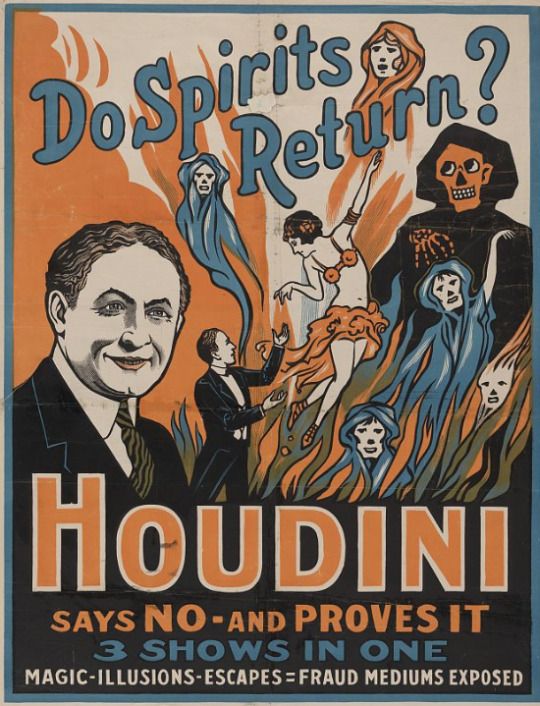
@subitized found this for me for Magnolia, Stay True inspiration. I feel like if this book ever gets a proper cover it should be in this style, but as of now I’m just setting this exact image as the cover on NaNoWriMo’s website so I don’t have to look at the weird default cover anymore.
[source] (ish)
#I wish I could find a more proper source for the image#like one that includes the year it was created in and some information about it#something slightly more academic I guess#but the library of congress blog is the closest I can find#it's not even sourced there!#someone tell me where it CAME FROM#story tag magnolia stay true
5 notes
·
View notes
Text
Periodic reminder that Archive of Our Own was created to be a repository for all written fanworks without regard to inherent worth, morality, ethicality, artistic merit, or intelligibility. As long as the posting of the work does not violate US law, falls within fair use standards, and does not directly harass individuals, it can be posted on Archive of Our Own.
Efforts to further limit the scope of what can be posted and stored on Archive of Our Own will fail, because Archive of Our Own is a repository much like the internet or the Library of Congress pre-21st century (back when it kept a copy of every publication printed in the United States). As long as you are able to find objectionable material on the internet or in a library, you will be able to find objectionable material in Archive of Our Own.
People get upset with the lack of moderation on Archive of Our Own because they view it as "the place to go to read fanfic." But when it was created, there was no goal for Archive of Our Own to be a destination fanfic reading website. Most people who first used it would publish on other sites (LiveJournal, fanfic.net, message boards, and various fandom-specific sites) to be read and commented on, and add a backup copy to Archive of Our Own so that it would be preserved in case it was ever removed from the original website/the original website went down. In other words, it was used as an archive, just like in the name.
AO3 can still be used this way! You can do your primary fanfic reading and writing on other sites, then back up your own works to AO3 for safekeeping.
Even better, if you object to the content that you find on AO3 and don't want to use it to find fanfic, or don't want to post there because you feel that posting there would be tantamount to endorsing AO3's mission, Archive of Our Own will hand you the tools you need to create your own site with more restrictive guidelines!
How? The software Archive of Our Own runs on is open source and the entire code is posted on github, along with advice for implementation.
Not everyone is comfortable searching for fanfic on Archive of Our Own for fear of encountering triggering or objectionable content. By creating more fanfic sites and repositories with their own focuses and guidelines, we can create the safe spaces in fandom that people are looking for without endangering the archival mission of Archive of Our Own.
6K notes
·
View notes
Text


In 2023, the National Recording Registry of the US Library of Congress was updated to, for the first time in its history, include a piece of video game music, namely the Super Mario Bros. overworld theme. A description of the piece and reasons for its inclusion by the Library of Congress is provided.
Main Blog | Twitter | Patreon | Small Findings | Source
2K notes
·
View notes
Text


Hobbs Mortuary, 6003 S. Compton Ave., Los Angeles (1992-1998)
Source: Library of Congress/Camillo Vergara
443 notes
·
View notes
Text
Hey folks, just dropping some resources here for those of you who, like me, are always on the hunt for free reading material, whether it's for research or just to satisfy your curiosity. If you're always looking to expand your reading list without breaking the bank, check these out:
Library of Congress: Absolute goldmine for academic researches and historical documents. You can spend hours diving into their collections.
Z-library: A treasure trove of books, articles, and papers on pretty much any topic you can think of. Quick downloads, no fuss.
Project Gutenberg: Free e-books galore, especially if you're into classics. Saved me from many a boring commute.
Internet Archive: A digital library offering free universal access to books, movies, and music, plus archived web pages. Endless hours of browsing joy.
Google Books: Sometimes you just need a quick peek inside a book without committing to buying it. Google Books has got your back.
Google Scholar: It scours through scholarly sources, journals, theses, and more. Just be ready to sift through some dense material.
JSTOR: Another heavyweight in the academic world. JSTOR is packed with scholarly articles, books, and primary sources across various disciplines. Some stuff may be behind a paywall, but there's still plenty to explore for free.
Newspaper Archive: Want to browse through historical newspapers? This site has a massive collection spanning centuries and covering a wide range of topics. Perfect for digging up primary sources.
Newspapers.com: Need more historical newspapers? Look no further.
Perseus Digital Library: Focuses on ancient Greco-Roman materials, perfect for those deep dives into classical history.
Digital Public Library of America: Another treasure trove of digitized materials, including photos, manuscripts, and more.
Europeana: European cultural heritage online. Images, texts, the whole shebang.
DOAJ: Open access journals. DOAJ indexes and provides access to high-quality, peer-reviewed open access research journals.
Open Library: Another digital library offering over 1.7 million free eBooks.
Librivox: Audiobooks for when your eyes need a break.
National Archives (UK): Offers access to a wealth of historical documents, including government records, maps, photographs, and more.
Sci-Hub: For the rebels. Access to scholarly articles.
Directory of Open Access Books (DOAB): Looking for free scholarly books? DOAB has got you covered with a vast collection.
Digital Commons Network: Free, full-text scholarly articles from hundreds of universities and colleges worldwide.
Directory of Open Access Repositories (OpenDOAR): Find open access repositories worldwide.
Gallica (Bibliothèque nationale de France): French flair for your research.
DigitalNZ: Your gateway to New Zealand's digital heritage.
#college life#study#resources#history nerd#anthropology#online learning#academic life#ResearchResources#DigitalArchives#free books#free#digital#archives#libraries#academic#research#books
109 notes
·
View notes
Text

"Dozens of people joined Biden administration officials, advocates and U.S. Sen. Peter Welch, a Democrat from Vermont, at a Washington public library on Tuesday to make a last-ditch plea to extend the Affordable Connectivity Program, a subsidy created by Congress and touted by President Joe Biden as part of his push to bring internet access to every U.S. household. The program, which is set to expire at the end of May, helps people with limited means pay their broadband bills.
“They need access to high-speed internet just like they need access to electricity,” Sen. Welch told the gathering. “This is what is required in a modern economy.”"
source 1
source 2
source 3
#destiel meme news#destiel meme#news#united states#us news#us politics#affordable connectivity program#acp#biden administration#internet access#internet connectivity#in today's society internet access is a basic right
80 notes
·
View notes
Text
Compiled list of sources
CONGO
https://cfr.org/global-conflict-tracker/conflict/violence-democratic-republic-congo
https://reporting.unhcr.org/operational/situations/democratic-republic-congo-situation
https://freetheslaves.net/our-work/where-we-work/dr_congo/
https://x.com/silvergrassleaf/status/1758832748649685247?s=20
https://www.amnesty.org/en/location/africa/east-africa-the-horn-and-great-lakes/democratic-republic-of-the-congo/report-democratic-republic-of-the-congo/
Congo Genocide Explained: EVERYTHING YOU NEED TO KNOW. (youtube.com)
CONGRESS: Do Not Allow Our Tax Dollars To Fund Conflict In The Congo! - Action Network
Congo Campaigns - Friends of the Congo
AeonThespain on Tumblr: Congo Action 3
healafrica.org
SUDAN
https://eyesonsudan.net/ & https://eyesonsudan.net/reading
https://ushmm.org/genocide-prevention/countries/sudan
https://salesianmissions.org/salesian_country/sudan/
https://twitter.com/longlivemireia/status/1721105158736658897?s=46&t=03WDSopg10j_4l7ZJXSPZQ
https://twitter.com/hkzuk/status/1722122606453661940?s=46&t=03WDSopg10j_4l7ZJXSPZQ
from the river to the sea 🍉🕊 on Tumblr: sudanese-led causes to donate to!
NasAlSudan on X: "The War in Sudan - A Thread. (1/5) #KeepEyesOnSudan #SudanActionWeek https://t.co/4B7BGgaAUk" / X (twitter.com)
HAITI
https://theguardian.com/world/2023/jan/12/haiti-crisis-jovenel-moise-gangs-water-way-out
https://reliefweb.int/report/haiti/abyss-despair-need-act-haiti-and-its-children-november-7-2023
https://aljazeera.com/where/haiti/
https://rescue.org/article/crisis-haiti-gang-violences-vice-grip-amidst-political-turmoil
https://nacla.org/guns-gangs-and-neocolonialism-hait
YEMEN
https://docs.google.com/document/d/1LWER5czCh8xqWDe32f1XqU843t4dkwYNMyvm8OkYVNc/mobilebasic
https://launchgood.com/campaign/water_4_yemen_1#!/
https://thepetitionsite.com/1/endhungerinYemen/
https://linktr.ee/helpsaveyemen
https://arabcenterdc.org/resource/a-timeline-of-the-yemen-crisis-from-the-1990s-to-the-present/
https://youtube.com/playlist?list=PLvP9M_2fl-eN5-GOOFSqKcCAmbD4sF0Ep
https://x.com/absolutelacunae/status/1760728489102332215?s=20
https://theworld.org/stories/2017-11-29/heres-how-you-can-send-help-people-trapped-worlds-worst-humanitarian-crisis
https://news.un.org/en/story/2019/02/1032811
A Timeline of the Yemen Crisis, from the 1990s to the Present (arabcenterdc.org)
TIGRAY
Ways to help Tigray: https://x.com/shimmeringolds/status/1719186653187613101?s=20
Resources: https://x.com/GLITCHDXCTORTTV/status/1759580042877599986?s=20
Ethiopia’s Invisible Ethnic Cleansing | Human Rights Watch (hrw.org)
Ethiopia’s New Year’s ledger: A controversial new port and domestic challenges | Brookings
Ethiopia in Troubled Waters | Council on Foreign Relations (cfr.org)
Ethiopia Humanitarian Crisis - Center for Disaster Philanthropy
Conflict in Ethiopia | Global Conflict Tracker (cfr.org)
X (twitter.com)
Free Tigray Movement
- (tigrayactioncommittee.com)
Tigray Genocide: Everything you need to know. (youtube.com)
United Tegaru Resource Carrd (stopthewarontigray.carrd.co)
Tigray needs YOUR help! | Linktree
WEST PAUPA
What's going on in Papua?: https://x.com/shimmeringolds/status/1761073053880942781?s=20
https://freewestpapua.org/Resources & info: https://x.com/folkoftheshelf/status/1746154482009018614?s=20
https://www.freewestpapua.org/documents/the-neglected-genocide-human-rights-abuses-against-papuans-in-the-central-highlands-1977-1978/ https://news.un.org/en/audio/2014/05/589082
https://newnaratif.com/explainer-whats-going-on-in-west-papua/
https://www.freewestpapua.org/take-action/
https://newnaratif.com/explainer-whats-going-on-in-west-papua/
sof’s library ✧˖°. 🥄 on X: "‘what’s happening in West Papua?’ — resources + info + how you can help: a thread https://t.co/4hWOTY6lFA" / X (twitter.com)
PUERTO RICO
𝐫𝐚𝐛𝐢𝐝𝐠𝐮𝐭𝐬 🫐🐾 on X: "since not enough people are talking about puerto rico heres a master 🧵 on information about the genocide going on, how the us is trying to make puerto rico an "american state", and how you can help !! https://t.co/NBJDIQiesi" / X (twitter.com)
‘Cultural Genocide’ in Puerto Rico Displaces Population, Destroys Heritage (sputnikglobe.com)
Puerto Rico | Genocide Studies Program (yale.edu)
Puerto Rico — 500 Years Of Oppression on JSTOR
Puerto Rico faces genocide – Workers World
2020 Plan Means Genocide for Puerto Rico! - Puerto Rican Cultural Center (prcc-chgo.org)
X (twitter.com)
X (twitter.com)
HAWAII
X (twitter.com)
Decolonizing genocide in Brazil: challenges to defending Indigenous collective life - IWGIA - International Work Group for Indigenous Affairs
2023 Point in Time Counts – Hawai'i Health Data Warehouse (hhdw.org)
Tourism's Negative Impact on Native Hawaiians (tripod.com)
Hawaii Tourism: Opposite of a Paradise for Locals (irreview.org)
X (twitter.com)
YANOMAMI
Decolonizing genocide in Brazil: challenges to defending Indigenous collective life - IWGIA - International Work Group for Indigenous Affairs
Yanomami (survivalinternational.org)
KASHMIR
Profile / X (twitter.com)
X (twitter.com)
Template for arms sales email - Google Docs
MYANMAR
Future Bleak for Rohingya in Bangladesh, Myanmar | Human Rights Watch (hrw.org)
Myanmar’s Troubled History: Coups, Military Rule, and Ethnic Conflict | Council on Foreign Relations (cfr.org)
BETTER BURMA
PAKISTAN
Pakistan dispatch: violent crackdown on peaceful Baloch protesters in Islamabad highlights ongoing injustices in Balochistan region - JURIST - News
EAST TURKISTAN
Camp Album Project – Art to Fight Xinjiang Abuse (camp-album.com)
IHH releases new report on East Turkestan | İHH Humanitarian Relief Foundation
Elderly Uyghurs die alone in jail, detained on trumped-up charges – The China Project
N 🖋️ on X: "A 🧵 about East Turkistan. What's going on and what can you do? From an Uyghur Girl: https://t.co/XPLS19T7fh" / X (twitter.com)
ARMENIA
Learn for Artsakh
RESOURCES_COMP.xlsx - Google Sheets
PLACES IVE MISSED
Cheaper & Deeper!! on Tumblr: People & countries mentioned in the thread: DR Congo - M23, Cobalt Darfur, Sudan - International Criminal Court, CNN, BBC...
a𓂆sa on Tumblr: IMPORTANT CRISES THAT ARE BEING IGNORED BY THE WORLD
#free tigray#free congo#free east turkistan#free kashmir#free hawaii#free puerto rico#free sudan#free west papua#free yemen#free haiti#free armenia#free yanomami#free myanmar
80 notes
·
View notes
Text

[ The skull of Tarbosaurus bataar, alongside artwork by palaeoartist Hank Sharpe. ]
"Homeland Security Investigations (HSI) returned an impressive collection of dinosaur fossils to Mongolia’s Ambassador to the United States, Batbayar Ulziidelger, at a ceremony at the Library of Congress on Aug. 3. The fossils were recovered through HSI investigations conducted by our offices in Arizona, New York, and Wyoming, and the collection was represented by a tyrannosaurus bataar skull, protoceratops fossil, alioramus skull, and saurolophus skull.
The alioramus, which resembles a smaller version of a tyrannosaurus rex, is exclusively found in Mongolia – the source of many, extremely rare fossils. The specimen on display at the ceremony is considered one of the best-preserved fossils ever found of the dinosaur that lived approximately 70 million years ago.


[ The skulls of Alioramus (left) and Protoceratops (right), alongside artwork by palaeoartist Hank Sharpe. ]
“Today’s event is dedicated to acknowledge the solid contributions of the officers and special agents from Homeland Security Investigations, U.S. attorneys, judges, scientists, and all individuals present here at ceremony as well as those who are absent due to their duty, who made this day possible,” said Ambassador of Mongolia Batbayar Ulziidelger. “This ceremony is a testament to the strong partnership between the Government of Mongolia and the Unites States and we are fortunate to witness the first-ever public display of these Mongolian dinosaur fossils.”
“We have gathered here to witness the return of dinosaur fossils from the United States to their homeland – Mongolia; these fossils, once lost to time and distance, now find their way back to the land, where they were first discovered,” said Minister for Foreign Affairs of Mongolia Battsetseg Batmunkh. “The remarkable journey of these artifacts demonstrates the strength of collaborative diplomacy and a solid dedication to preserving our cultural heritage. I am delighted to acknowledge the valuable contributions of law enforcement officers and special agents, agencies, attorneys, judges… our collective efforts demonstrated the potential to effectively fight illegal smuggling, both bilaterally and multilaterally.”
The first of these cases began in May 2012 when HSI New York initiated a cultural property investigation after receiving information alleging the illicit sale of protected fossils by a U.S.-based auction house. The investigation revealed that an individual, who later pled guilty to criminal counts of illegal importation of dinosaur fossils, was selling a fossilized alioramus skull through the auction house; that skull is part of the collection being returned.
That same year, HSI Casper, Wyoming office received an HSI Tip Line report that a retail store was selling a fossilized tyrannosaurus bataar skull. HSI Casper began its investigation relating to the illegal importation and subsequent sale of dinosaur fossils originating from Mongolia, which has strong patrimony laws that prohibit the export of prehistoric fossils.
These investigations led to multiple seizures of a wide range of paleontological fossils illegally taken from their country, including:a rare juvenile tyrannosaurus battar skull; a fossilized gallimimus skeleton; a tarbosaurus bataar skeleton; nests of dinosaur eggs; a saber-toothed cat skull; a complete psittacosaurus skeleton; and a protoceratops skull. Some of these dinosaurs lived more than 100 million years ago in an area now known as the Gobi Desert."
Read more: "HSI repatriates high-profile dinosaur fossils to Mongolia"
#Palaeoblr#Palaeontology#Paleontology#Fossils#Dinosaurs#Repatriation#Article#Tarbosaurus#Tarbosaurus bataar#Alioramus#Theropod#Protoceratops#Ceratopsian#Photos#Art#Cretaceous#Mesozoic#Prehistoric#Extinct
192 notes
·
View notes
Text
Hmm:

Regarding tenzu tablets:
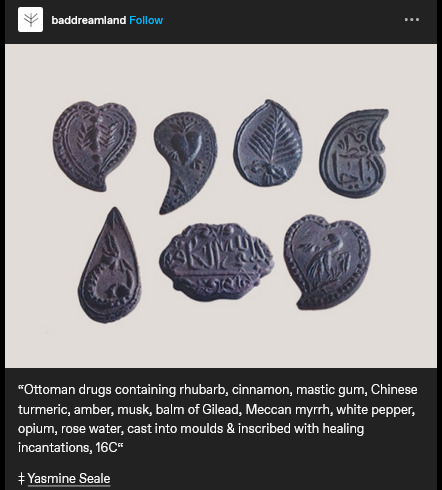
Caption reads: "Ottoman drugs containing rhubarb, cinnamon, mastic gum, Chinese tumeric, amber, musk, balm of Gilead, Meccan myrrh, white pepper, opium, rose water, cast into moulds & inscribed with healing incantations, 16C". Credited with a link to Yasmine Seale, on social media.
Original linked source doesn't mention where these particular tablets/molds were created, kept, displayed, etc. But I wanted to learn more and found a kinda recent summary of tenzu which was published by Nil Sarı (head of History of Medicine and Ethics Department at Istanbul University's Cerrahpasha medical school, president of Health History and Museology Association), which was presented at a conference in 2016:
Nil Sarı. "The Special Pharmaceutical Tablet “Tenzu” in Ottoman Medicine.” 7th International Congress for History of Islamic Medicine, October 24-28, Fez, Morocco, 2016: 24-28.
An excerpt of the text:
In Ottoman Turkish tenzu (tensuh) means "very rare beautiful thing" or "a box containing a variety of fragrances." Tenzu was also said to be the name of a place in Hitay (Eastern Turkistan / Xinjiang) where a medicinal clay - the main ingredient of the tablet tenzu - was imported from. Tenzu was a kind of theriac said to be effective against various ailments. Different tenzu prescriptions are noted in the texts [...] of several medical manuscripts of the 17th and 18th centuries. These tenzu prescriptions were described by various physicians, e.g. the head physicians Salih bin Nasrullah and Nuh Efendi as well as Hayatizade Mustafa Feyzi and Shaban Shifai who were palace physicians of the period. The special pharmaceutical tablet/pastille named "tenzu kursu" was formed in various shapes, i.e. oval, round, or rectangular. A measured amount of the drug preparation was compressed and shaped in a special brass mold named "tenzu kalibi" in Turkish. [...]
Prayers and ornamentations are engraved on the metal molds [...]. The expressions Deva al kulub (Drug for the heart) and Shifa al marghoob (The desired, yearned healing) inscribed on molds reinforce spirituality. [...] Inscriptions around the center of the other flower shaped pattern are Ferd, Hayy, Kayyum and feehi shifaun lin-naas (wherein is healing for mankind, Surah an-Nahl, verse 69). [...] Al-Hayy and Al-Qayyum are often used together. Al-Hayy signifies "ever-lasting life", and Al-Qayyum "self-existing life". [...] Sihhat bad (Have a good health) and Afiyet bad (Have a good appetite) are inscribed. [...] A. Suheyl Unver and Hayri Sozen published several tenzu prescriptions in their book "Turk Farmakaloji Tarihi I.", in 1960. [...] Tenzu prescriptions are found in several medical manuscripts kept in the Topkapi Palace Library, Suleymaniye Library and Istanbul University Rare Books Library.
Clay is a main ingredient [...]. Tiyn-i Tenzu is an unknown red colored clay. However, Terra Sigillata (Tiyn-i mahtum / muhurlu toprak) and Armenian Clay (Kil ermeni) are found in the prescriptions. [...] There are also animal products in the compositions, i.e. ambergris (amber), bezoar (badzehr), kermes (kirmiz), musk (misk), raw silk (harir-i ham / ham ipek), [...] and burnt deer antler (yanmisgeyik boynuzu). There are a wide variety of herbal drugs in the compositions, i.e. Acorus calamus [...], Aloe vera (Sabir), [...] Anchusa offinalis (Lisan-i sevr cicegi), Artemisia absinthium [...], Bambusa arundinaceae [...], Chenopodium album [...], Cinnamon (Darcin), Citrus aurantium [...], Crocus sativus (Za'feran), Embellia ribes [...], Gummi mastix [...], Heliotropium arborsecens [...], Nardustachys jatamansi [...], Potentilla reptans [...], Pterocarpus santalinus [...], Red rose/Rosa gallica [...], Rheum officinale (Ravend), Rumez acetosellaseed [...], Ruta graveolens (Keci Sadefi/Sedef Otu), Terminalia citrina [...], Terminalia chebula [...], Tormentilla (Tormentila).
Shaping and storage of these drugs are explained alongside some of the tenzu prescriptions. According to a recipe, all ingredients are beaten very thin on a porphyry (onyx marble) [...]. Each dose wrapped in gold foil is anointed an amount of almond oil. It is pressed into the mold, dried in the shade and stored in wood boxes. [...] Drugs in tablet form was an old tradition. In general, the preparation is poured onto a tray. [...] After dried in the shade, orange leaves are put between them. Stored in colored glass containers, they're reused when needed, squashed with water and drunk as a syrup. Also, flat pills made of a drachma weight were retained on the tongue in the mouth [...]. Although drugs in tablet form were used throughout Ottoman history either as a pastille or to be converted into syrup, the tenzu tablet molds were designed for the Ottoman sultans and members of the dynasty to make special tablets decorated with calligraphy [...].
[End of excerpt.]
All of these images are cropped screenshots of the PDF scan of the printed "conference works"; the PDF was uploaded online by Nil Sarı.


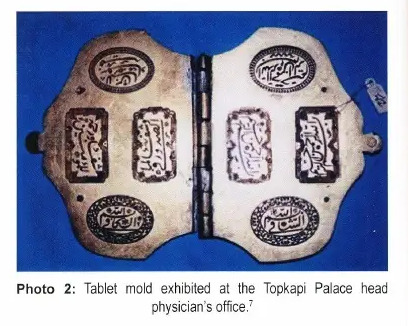

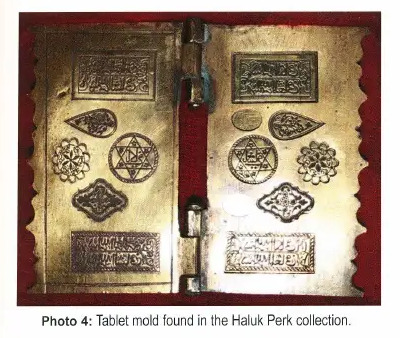
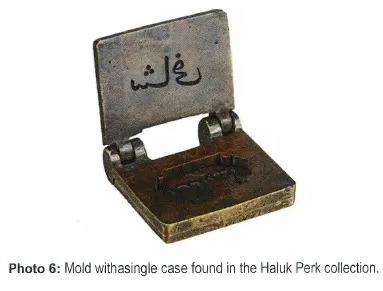
#sorry some of the non english is messed up because i had to transcribe the text myself from the image scans#also like that the Special Sweets Kitchen of the palace produced medicine
133 notes
·
View notes
Note
Hey, where did you find the Doings of the Duffs? I'm trying to find a good source for the unedited strips.
Check out the Library of Congress’ Chronicling America web site — a public domain archive of newspapers dating back to 1756!
33 notes
·
View notes
Text
Tumblr, help! In drafting a post centering on Hamilton’s artillery company, I’m having to look at some of Alexander Hamilton’s pay book for the company [x], and I’ve noticed this (the below images) within one of the weekly return tables Hamilton wrote. However, I’ve only been able to decipher some of this note. This section of the book (images 182-185) is not included in The Papers of Alexander Hamilton for whatever reason, only the middle section with his notes on Plutarch and Postlethwayt.
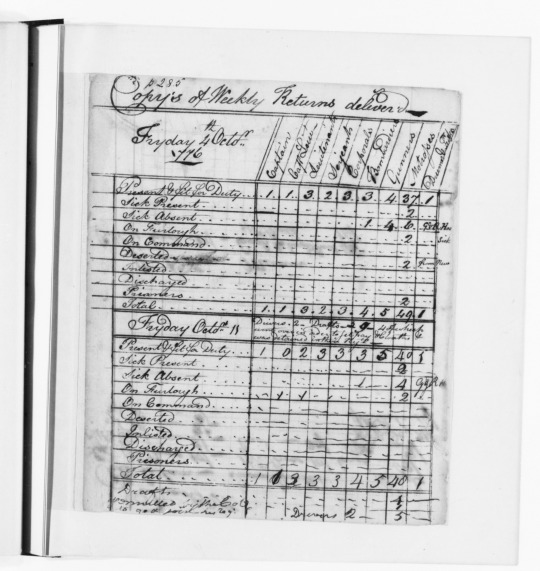
Here’s the full page, and below a close up of the note at the header of the October 11th table. Also interesting to note are the “Prisoners” rows but that’s besides the point.

Source: Image 184 of the Alexander Hamilton Papers: Miscellany, 1711-1820; Military papers; By period; American Revolution, 1775-1783, Library of Congress. [link here].
Here’s what I’ve managed to read:
Drivers. 2 - Drafts 29 4 [Something starting in A] went over in Dec to see how [something] was detained in this reg't
If anyone has any ideas, please feel free to tackle this for yourselves!
#grace’s random ramble#amrev#need help#alexander hamilton#historical alexander hamilton#captain hamilton#historical documents#library of congress#handwriting#historical handwriting#the american revolution#american revolutionary war#amrev fandom#hamilton letters#historical hamilton#american history
33 notes
·
View notes
Text
Lithograph of poison parsley (aethusa cynapium) and fly agaric mushroom (amanita muscaria) by Augustus Kollner, 1813-1906.
Source: Library of Congress
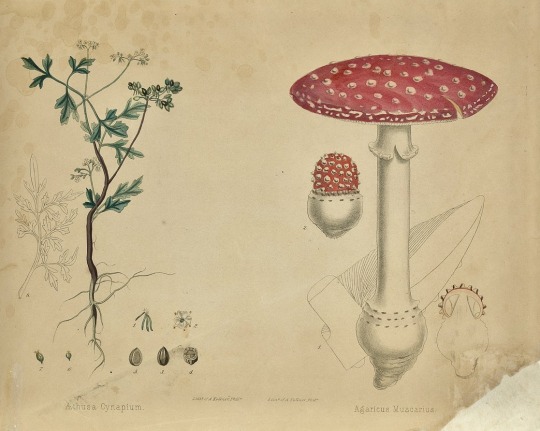
#poisonous plants#poisonous mushrooms#botanical illustration#aethusa cynapium#poison parsley#fly agaric#amanita muscaria#poison path#bane folk
66 notes
·
View notes
Text
Caleb Brewster's signature, an evolution 1778-1780
We start off reasonable and professional, in a letter to Benjamin Tallmadge dated October 22, 1778:
Caleb Brewster Lieut

Source: Library of Congress, https://www.loc.gov/resource/mgw4.053_0566_0567/?sp=1
That's good, you know, pretty solid. Clean, neat, mindful of his military position. Then a bizarre and exciting change of pace in a letter to Benjamin Tallmadge dated February 26, 1779.
I am with respect yours [etc.?] Caleb Brewster
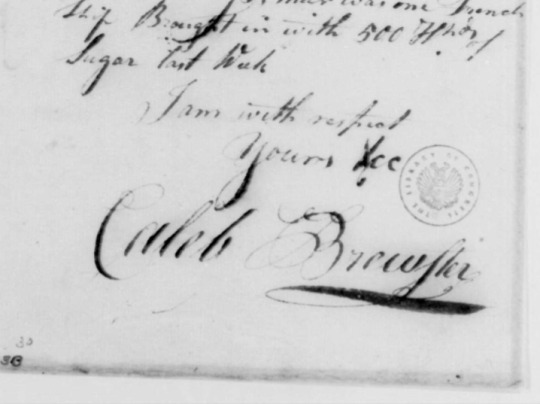
Source, Library of Congress, https://www.loc.gov/resource/mgw4.056_0281_0284/?sp=4&st=image
Incredible. Diva. I'm amazed he found stable ground to write this on and enough time to compose two pages. The "B" should be framed and taught in calligraphy classes. In the same letter, he writes a "g" so effusive it bisects New York in the row below to land on "at".

Was it too much? Did he fly too close to the sun? Has he since grown more secure in his correspondence or is this him at his most confident? Either way, 18 months later we see a more subdued return to form in a letter to Benjamin Tallmadge dated August 18, 1780.
With respect your friend and Humble Servant Caleb Brewster
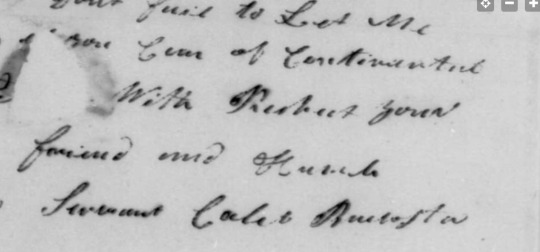
Source: Library of Congress, https://www.loc.gov/resource/mgw4.069_0709_0710/?sp=1
No flourishes, short lines-- in fact, a total lack of swoops throughout the entire letter. But he's become a friend! Aww. I wish I knew what Maj. Tallmadge had written in return.
Other things I have found out while doodling on the themes of Chapter 18 of Wind and Water and researching tangents,
Caleb and Ben owned land together (?!?!), purchased August 5, 1784: "The Middle of the Island Farm" in Brookhaven Twp. and four lots in Nocamack. (The source given, that I can't access, is this: Page 251 Loyalism in New York during the American Revolution by Alex C Flick PhD. Columbia Univ. Press, London 1901. Accessed Meehan-411 16 Jan 2020.)
Caleb's father's name was Benjamin, likely the reason his son was also called Benjamin (another son was named Daniel, for his grandfather). His first daughter was named after his mother, Sarah.
He had three half-sisters from his father's first or second wife? (https://www.wikitree.com/wiki/Brewster-1687) Except the birth dates make it seem like Caleb was somehow born between the last two? Someone messed up the geneology there, or we're talking bigamy.
#yes I am roasting a man who died 196 years ago about his signature#history things#18th Century#caleb brewster#turn amc#American Revolution#tallster
95 notes
·
View notes
Photo




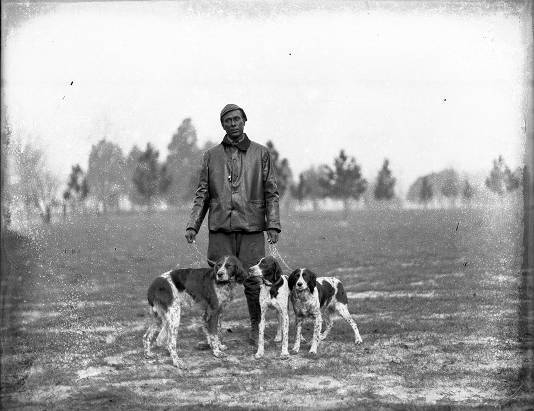




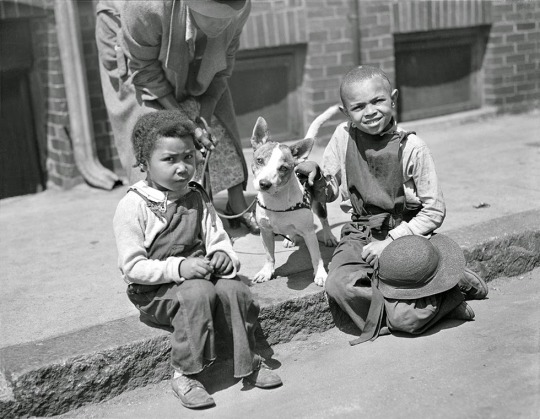
There’s a deeply rooted misconception that the only history that Black people have with dogs is a violent one. We recall the stories of slave patrols (the early prototype of our present law enforcement in the United States) enslaved people and free people of color through the swamps and forests with bloodhounds. Our minds turn to images of dogs being weaponized by white officers to intimidate and injure activists and community members. We reinforce narratives that nurture this haunted history of violence. But that is not the full story.
So here’s a little community history that show Black folk being pet parents and companions to furbabies~
- Bartel and Vashti Mosby, sitting together in front of their home with a small terrier in Lincoln, Nebraska (1910 - 1925)
- A young girl and elder stand on porch with cat (1928)
- Unidentified woman sitting with dog (1910)
- Children play with dog on the beach in Apalachicola, Florida (1895)
- A hunter stands with three hunting dogs in Georgia (1926)
- A mother surrounded by three children and a dog in rural Wilcox County, Alabama (1910-1919)
- A small child smiles down two dogs in Lincoln, Nebraska (1919-1925)
- At West Park Animal Hospital in West Philadelphia (born and raised~) a multi-racial team including Howard Krawitz and Whitfield Thompson (pictured) crafted a prosthetic cart for a puppo named Peanuts (1964)
- Two women at a picnic show off their smiling pitbull terrier (1910-25)
- Two children with dog in Boston, Massachusetts
Collection sourced from Florida Memory | Smithsonian | Library of Congress | New York Public Library | Nebraska Public Library | Boston Public Library
#for my afrofolio of period dramas#black history month#BlackExcellence365#people#our history is your history#yes i did make a fresh prince joke#in west philadelphia born and raised~
244 notes
·
View notes